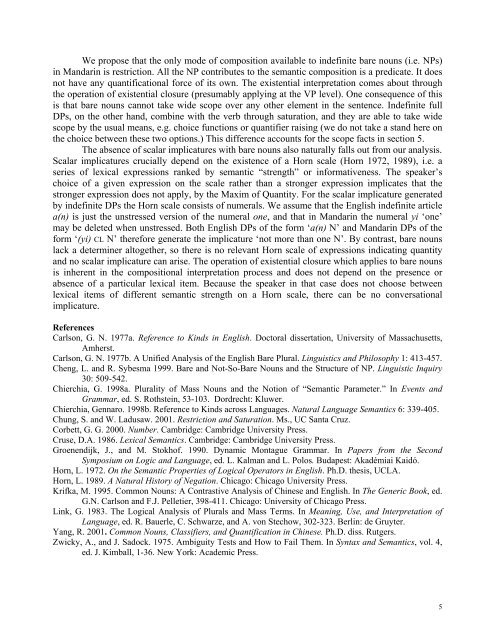SemPrag03.Progr.pdf - Institut für Linguistik/Germanistik - Universität ...
SemPrag03.Progr.pdf - Institut für Linguistik/Germanistik - Universität ...
SemPrag03.Progr.pdf - Institut für Linguistik/Germanistik - Universität ...
You also want an ePaper? Increase the reach of your titles
YUMPU automatically turns print PDFs into web optimized ePapers that Google loves.
We propose that the only mode of composition available to indefinite bare nouns (i.e. NPs)<br />
in Mandarin is restriction. All the NP contributes to the semantic composition is a predicate. It does<br />
not have any quantificational force of its own. The existential interpretation comes about through<br />
the operation of existential closure (presumably applying at the VP level). One consequence of this<br />
is that bare nouns cannot take wide scope over any other element in the sentence. Indefinite full<br />
DPs, on the other hand, combine with the verb through saturation, and they are able to take wide<br />
scope by the usual means, e.g. choice functions or quantifier raising (we do not take a stand here on<br />
the choice between these two options.) This difference accounts for the scope facts in section 5.<br />
The absence of scalar implicatures with bare nouns also naturally falls out from our analysis.<br />
Scalar implicatures crucially depend on the existence of a Horn scale (Horn 1972, 1989), i.e. a<br />
series of lexical expressions ranked by semantic “strength” or informativeness. The speaker’s<br />
choice of a given expression on the scale rather than a stronger expression implicates that the<br />
stronger expression does not apply, by the Maxim of Quantity. For the scalar implicature generated<br />
by indefinite DPs the Horn scale consists of numerals. We assume that the English indefinite article<br />
a(n) is just the unstressed version of the numeral one, and that in Mandarin the numeral yi ‘one’<br />
may be deleted when unstressed. Both English DPs of the form ‘a(n) N’ and Mandarin DPs of the<br />
form ‘(yi) CL N’ therefore generate the implicature ‘not more than one N’. By contrast, bare nouns<br />
lack a determiner altogether, so there is no relevant Horn scale of expressions indicating quantity<br />
and no scalar implicature can arise. The operation of existential closure which applies to bare nouns<br />
is inherent in the compositional interpretation process and does not depend on the presence or<br />
absence of a particular lexical item. Because the speaker in that case does not choose between<br />
lexical items of different semantic strength on a Horn scale, there can be no conversational<br />
implicature.<br />
References<br />
Carlson, G. N. 1977a. Reference to Kinds in English. Doctoral dissertation, University of Massachusetts,<br />
Amherst.<br />
Carlson, G. N. 1977b. A Unified Analysis of the English Bare Plural. Linguistics and Philosophy 1: 413-457.<br />
Cheng, L. and R. Sybesma 1999. Bare and Not-So-Bare Nouns and the Structure of NP. Linguistic Inquiry<br />
30: 509-542.<br />
Chierchia, G. 1998a. Plurality of Mass Nouns and the Notion of “Semantic Parameter.” In Events and<br />
Grammar, ed. S. Rothstein, 53-103. Dordrecht: Kluwer.<br />
Chierchia, Gennaro. 1998b. Reference to Kinds across Languages. Natural Language Semantics 6: 339-405.<br />
Chung, S. and W. Ladusaw. 2001. Restriction and Saturation. Ms., UC Santa Cruz.<br />
Corbett, G. G. 2000. Number. Cambridge: Cambridge University Press.<br />
Cruse, D.A. 1986. Lexical Semantics. Cambridge: Cambridge University Press.<br />
Groenendijk, J., and M. Stokhof. 1990. Dynamic Montague Grammar. In Papers from the Second<br />
Symposium on Logic and Language, ed. L. Kalman and L. Polos. Budapest: Akadémiai Kaidó.<br />
Horn, L. 1972. On the Semantic Properties of Logical Operators in English. Ph.D. thesis, UCLA.<br />
Horn, L. 1989. A Natural History of Negation. Chicago: Chicago University Press.<br />
Krifka, M. 1995. Common Nouns: A Contrastive Analysis of Chinese and English. In The Generic Book, ed.<br />
G.N. Carlson and F.J. Pelletier, 398-411. Chicago: University of Chicago Press.<br />
Link, G. 1983. The Logical Analysis of Plurals and Mass Terms. In Meaning, Use, and Interpretation of<br />
Language, ed. R. Bauerle, C. Schwarze, and A. von Stechow, 302-323. Berlin: de Gruyter.<br />
Yang, R. 2001. Common Nouns, Classifiers, and Quantification in Chinese. Ph.D. diss. Rutgers.<br />
Zwicky, A., and J. Sadock. 1975. Ambiguity Tests and How to Fail Them. In Syntax and Semantics, vol. 4,<br />
ed. J. Kimball, 1-36. New York: Academic Press.<br />
5

















